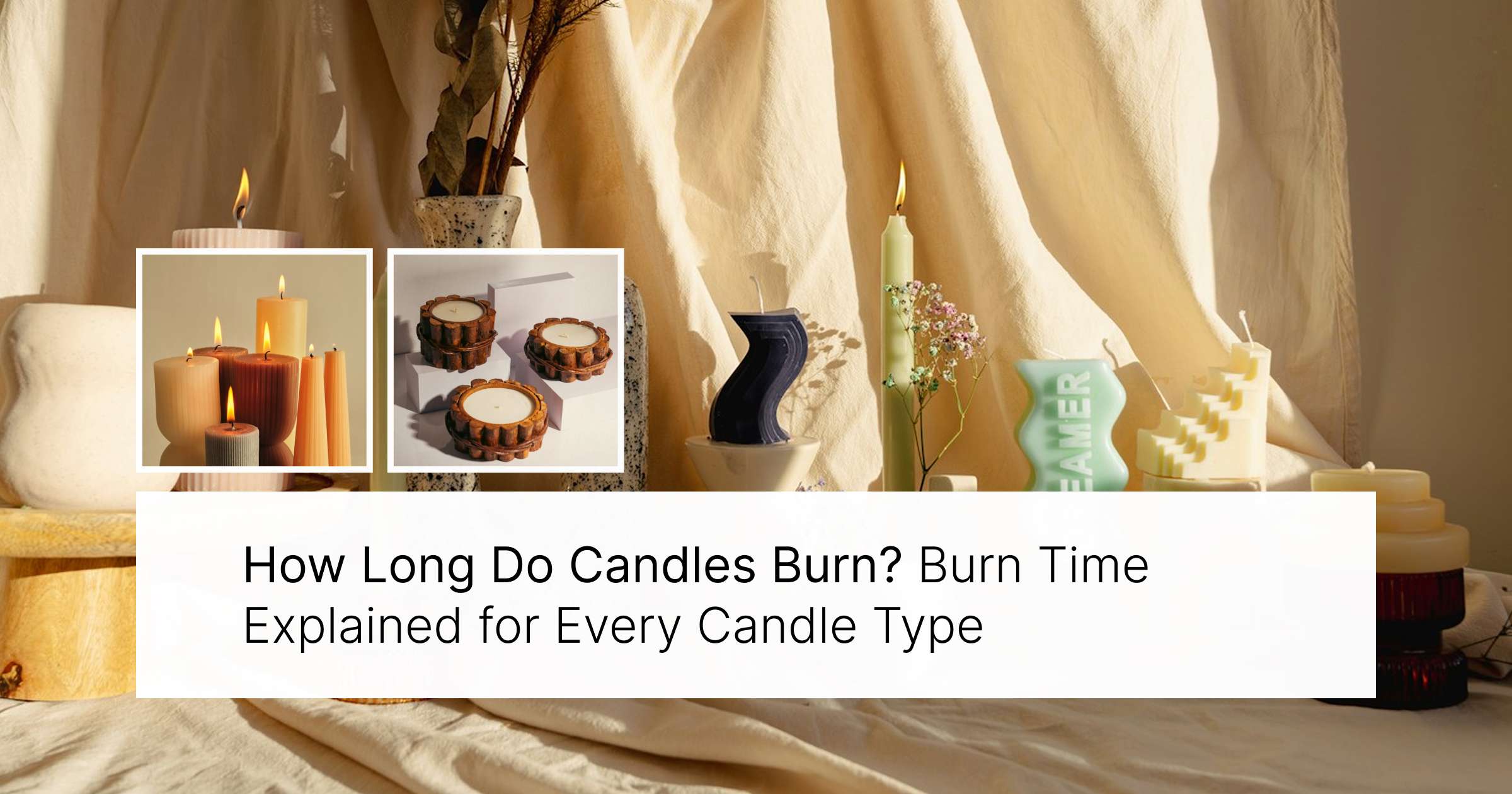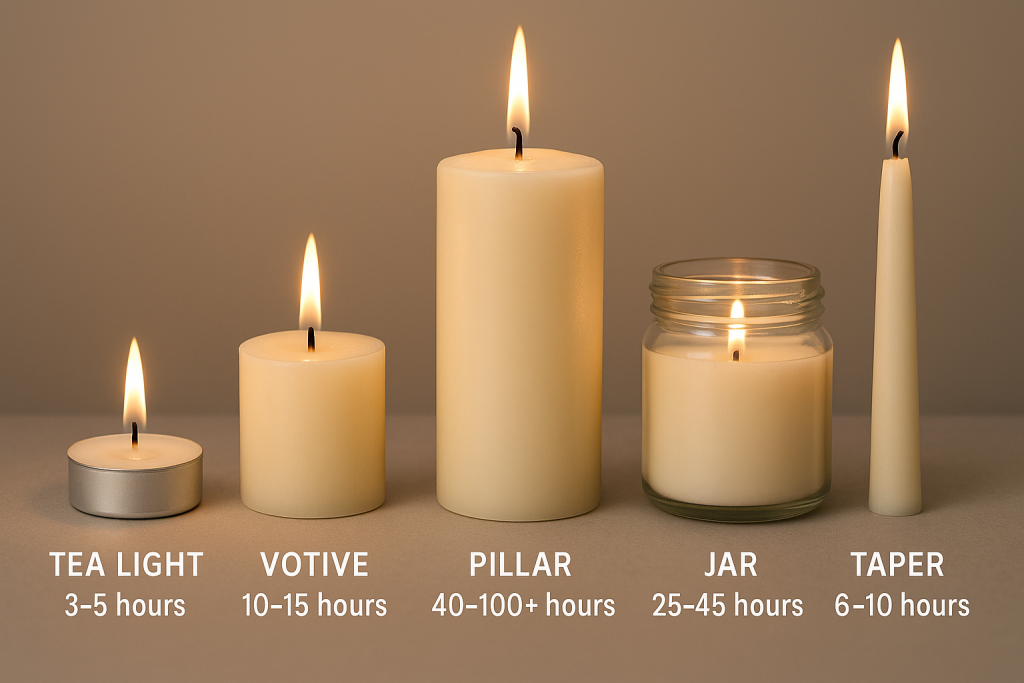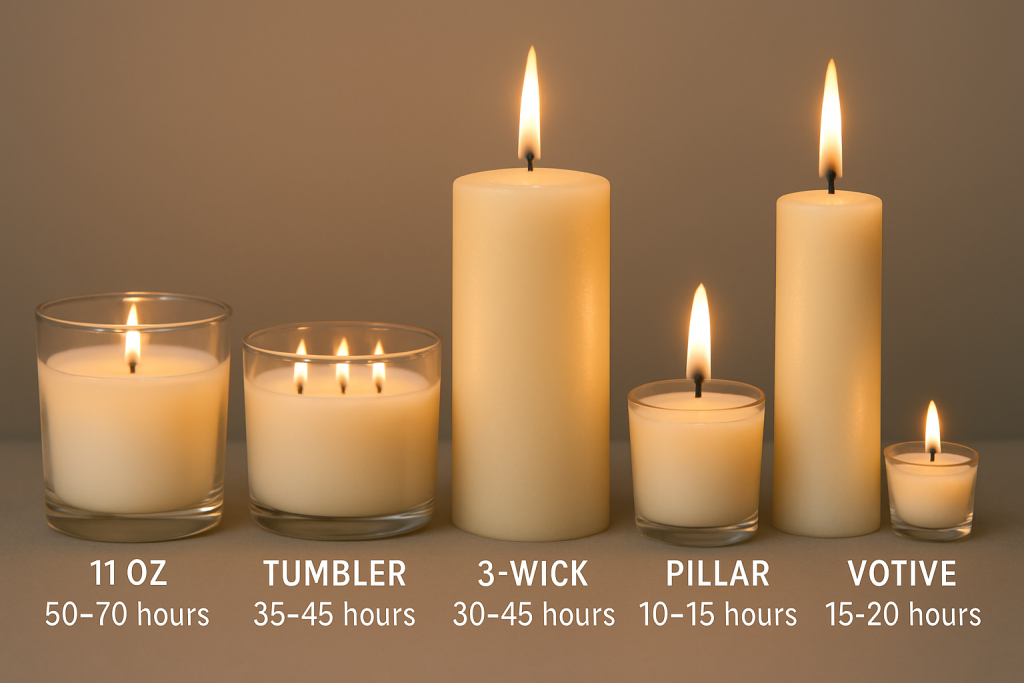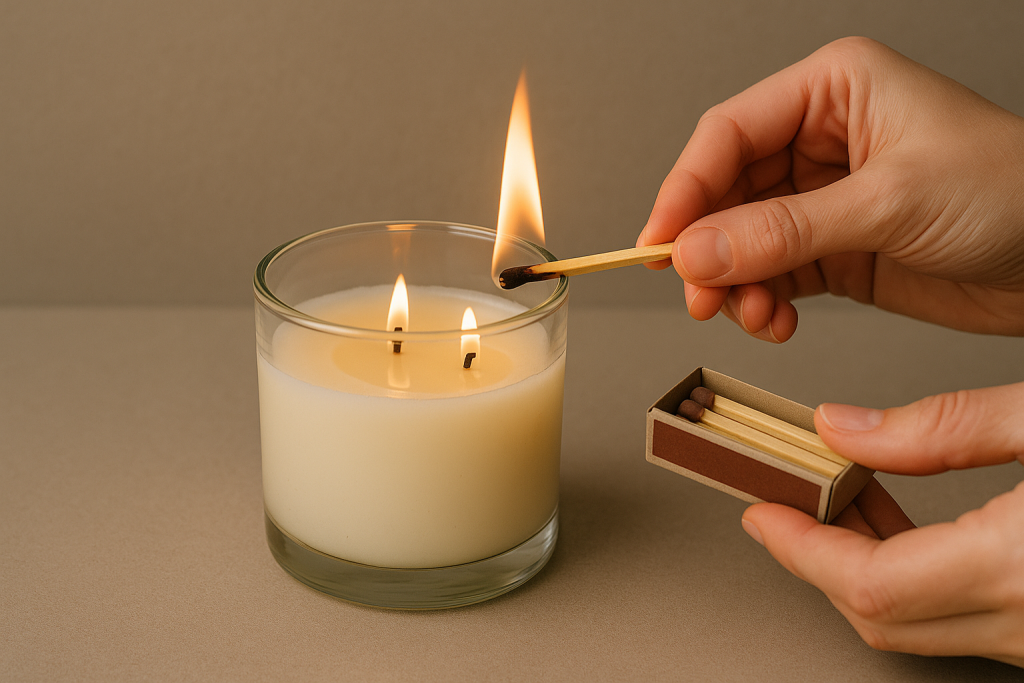No products in the cart.
How Long Do Candles Burn? Burn Time Explained for Every Candle Type
- Nav Preet
- No Comments

There’s something deeply soothing about the gentle flicker of a candle — whether it’s setting the mood for a cozy night in, adding ambience to a dinner table, or simply filling the room with a calming scent.
But if you’ve ever wondered how long candles burn or why some last much longer than others, you’re not alone.
Understanding candle burn time isn’t just about curiosity — it matters for a few very practical reasons. First, it helps you get more value from every candle purchase. Second, it ensures you’re using them safely.
And third, if you’re lighting candles for specific events or rituals, knowing their approximate burn time helps you plan better.
So, how long do candles last? The answer depends on several factors — the type of candle, its size, the kind of wax, wick material, how you burn it, and even the shape of its container.
Let’s break it all down.
What Is Candle Burn Time?
Candle burn time is the estimated amount of time a candle can stay lit before it’s used up. This metric is often listed on packaging and varies significantly depending on size, wax type, and other factors.
Paying attention to burn time is important if you’re looking to get the best value from your purchase. It also ensures you’re not surprised halfway through a relaxing bath when your favorite candle suddenly flickers out.
How Burn Time Is Measured
Manufacturers usually test burn time in a controlled environment. This involves lighting the candle for intervals (typically 3-4 hours at a time), measuring how much wax is consumed, and extrapolating from there.
There’s a difference between continuous burn (leaving the candle lit nonstop) and intermittent burn (lighting it in shorter sessions). Both can yield different lifespans depending on how the candle reacts to heating and cooling cycles.
You can use our burn time calculator for estimated candle burn time.
Average Burn Time by Candle Type

1. Tea Light Candles
These small, disc-like candles usually last between 3 to 5 hours. Though short-lived, they’re perfect for creating ambient lighting or diffusing essential oils in warmers.
2. Votive Candles
Votives tend to burn anywhere from 10 to 15 hours. They’re often used in religious or decorative settings and require a snug container to burn evenly and safely.
3. Pillar Candles
Pillar candles are long-lasting, with burn times ranging from 40 to over 100 hours, depending on their height and width. A wide base allows for a slower, more even melt.
4. Jar Candles
A fan favorite, jar candles come in all sizes — their burn times can vary from 20 hours for smaller jars to over 100 hours for larger ones. The container helps shield the flame and slow down the burn rate.
5. Taper Candles
Often used for formal dinners and events, taper candles burn for approximately 6 to 10 hours. Because they’re thin and tall, they’re more vulnerable to drafts, which can shorten their lifespan.
Key Factors That Affect Candle Burn Time
1. Wax Type
Not all waxes are created equal. Soy candles generally burn longer and cleaner than paraffin, while beeswax offers an even slower burn but tends to be more expensive. Coconut wax is a newer alternative that burns slowly and throws scent well.
Each wax type has a different melt point, density, and burn speed — all of which contribute to total candle life.
2. Wick Size & Material
Wick size might seem like a small detail, but it plays a major role in how long a candle burns. Cotton wicks are common, while wood wicks (used in brands like WoodWick) burn differently and produce crackling sounds.
A thicker wick draws up more wax and creates a bigger flame, which means faster burn. A smaller wick may conserve wax but could also result in a smaller melt pool and scent throw.
3. Container Design & Shape
The shape and width of the container also matter. A wide jar exposes more wax to heat, speeding up burn time. Thicker glass can insulate and prolong use, while open-top designs are more susceptible to drafts and uneven burning.
4. Candle Size & Weight
The total amount of wax in a candle essentially acts as its fuel tank. A 16-oz jar will last longer than a 2-oz tin. Generally, the larger and heavier the candle, the longer the burns — assuming it’s burned properly.
How to Make Candles Burn Longer
1. Trim the Wick
One of the easiest and most overlooked tips: always trim your wick to about 1/4 inch before lighting. This prevents soot, mushrooming, and high flames, all of which cause your candle to burn faster than necessary.
2. Let the Wax Pool Fully
When you light a new candle, let it burn until the entire surface has melted into a pool of liquid wax. This can take 2–4 hours. Skipping this step can cause tunneling, where wax around the edges never melts, shortening the candle’s life.
3. Store Candles Properly
Keep your candles in a cool, dry place away from direct sunlight and humidity. Heat can soften the wax, alter fragrance, and compromise performance over time.
4. Burn in Ideal Conditions
Avoid burning candles in drafty areas or near fans and open windows. Sudden airflow can cause the flame to flicker, leading to uneven wax use and a reduced burn time.

Burn Time Estimates by Candle Size
| Candle Size | Average Burn Time |
| 2 oz | 10–15 hours |
| 4 oz | 20–30 hours |
| 8 oz | 40–55 hours |
| 16 oz | 80–100+ hours |
| 3-wick | 25–45 hours |
Keep in mind, these are averages. A 16-oz soy candle may burn slower than a paraffin candle of the same size. Brand formulas and wick placement also impact longevity. Always check manufacturer estimates but test them in your real environment.
How Long Do Diptyque Candles Last?
Diptyque candles are more than just a luxury décor piece — they’re known for their exceptional fragrance quality, chic Parisian design, and long-lasting performance. But how long do Diptyque candles burn?
A standard 190g Diptyque candle typically offers a burn time of 50 to 60 hours when used correctly. This makes them a solid choice for those who want both scent throw and longevity in a premium candle.
Smaller versions, like the 70g mini candles, offer around 20 hours of burn time, while their larger multi-wick options can last well over 100 hours.
What sets Diptyque apart is its high-quality wax blend, which is carefully formulated to burn cleanly and distribute fragrance evenly. Combined with their precision-cut cotton wicks, the candles are engineered to melt consistently and avoid common issues like tunneling or smoking.
However, to get the most out of your Diptyque candle, proper care is still essential. Always trim the wick to about 1/4 inch before each use, allow the wax to pool fully across the top before extinguishing, and keep the candle away from drafts or fans. With these habits in place, you’ll maximize both the scent experience and total burn time.
How to Test Burn Time at Home
If you’re curious about how your candle performs, it’s easy to test the burn time at home. Here’s how to do it:
- Burn the candle for set intervals (like 1 or 2 hours)
- Measure how much wax is consumed or how much shorter the wick becomes
- Record the total time until the candle no longer lights or hits the bottom
This method helps you compare different brands and wax types, especially if you’re making candles yourself or buying in bulk.

How Long Should You Burn a Candle Per Session?
One of the most important yet overlooked aspects of candle care is how long you should burn it in a single session. Ideally, a candle should be burned for 2 to 4 hours at a time.
This window is long enough to allow the wax to melt evenly across the entire surface, creating what’s called a full “melt pool.” Achieving this during the first few burns is crucial — it helps prevent tunneling, where wax builds up along the sides and shortens the candle’s overall life.
Burning a candle for too long — usually over 5 hours — can be risky. The wick may become unstable or produce a larger flame, leading to “mushrooming” or soot buildup. In some cases, the container itself may overheat and become unsafe, especially if the wax level gets too low.
To stay safe and get the best performance, keep an eye on the time while burning. Once a full melt pool has formed and the room is nicely fragranced, it’s a good idea to extinguish the flame, let it cool, and trim the wick before the next use. These small steps can greatly extend the life of your candle.
Signs That a Candle Is Near the End of Its Life
Not sure if your candle is done? Here are a few signs:
- The wick is too short to stay lit
- There’s only ½ inch of wax left at the bottom (don’t burn lower for safety reasons)
- The flame keeps flickering or going out
- The scent throw is noticeably weaker
It’s better to retire a candle a little early than risk overheating the bottom of the jar or cracking the container.
Final Candle Burn Tips for Longer Life
To get the most out of every candle, a few simple habits can go a long way. First, always trim the wick to about 1/4 inch before lighting. This prevents large, smoky flames and reduces the chance of soot buildup or wick mushrooming, both of which can shorten the candle’s lifespan.
When you light a new candle for the first time, let the wax melt to the edges before blowing it out. This initial “memory burn” prevents tunneling and ensures that the wax continues to melt evenly in future uses.
Avoid burning candles in drafty rooms or near open windows and fans. A flickering flame caused by air currents leads to uneven burning and faster wax depletion.
Always use a stable, heat-resistant holder, especially for pillar and taper candles, to ensure even positioning and prevent accidents.
Never move a candle while it’s lit or the wax is still hot, as this can damage the wick or cause spills.
Finally, store your candles with their lids on, away from direct sunlight, heat, or dust. This keeps the wax stable and the fragrance fresh.
These tips not only improve safety, but they also help you get the full burn time and best value out of every candle.
Final Thoughts
Candle burn time isn’t just about hours on a label — it’s a mix of science, materials, and care. From petite tea lights to luxurious 3-wick jars, knowing how long candles burn helps you plan better, spend smarter, and enjoy them more safely.
Whether you’re wondering how long soy candles last or comparing burn durations between jar and taper candles, the key is understanding what affects their performance. Wax, wick, size, and burning habits all play a role.
So next time you shop for a candle, take a moment to check its burn time — and treat it right to make every flame last.
Frequently Asked Questions About Candle Burn Time
Do Bigger Candles Burn Longer?
Generally, yes. Larger candles have more wax, which means more fuel and longer burn times. But it’s not just about size — wick type, wax composition, and how well you burn it (like trimming the wick) also make a big difference.
Why Is My Candle Burning Too Fast?
If your candle seems to vanish in just a few hours, it could be due to a few common mistakes: not trimming the wick, using it in a drafty spot, or a poor-quality wax formula. Candles with oversized wicks tend to burn hot and fast.
Can I Relight a Candle That Burned Unevenly?
Yes. If your candle is tunneling — where the center burns but the edges stay untouched — you can fix it. One popular method is the foil wrap trick: wrap the top of the candle with aluminum foil (leaving the center open) and let it burn for an hour or so. It helps melt the edges evenly.
Is Burn Time Written on Candle Packaging Accurate?
Most brands calculate burn time under controlled lab conditions, so the real-world result may differ. If you burn your candle for shorter periods and follow best practices, you may get even more out of it than advertised.

Nav Preet is the founder and creative soul behind Karigar Candles. Inspired by heritage, nature, and the warmth of handmade artistry, she crafts candles that do more than glow—they evoke emotion. Through this blog, she shares her love for scents, styling, and mindful living, one flame at a time.
Creative Head at Karigar Style







